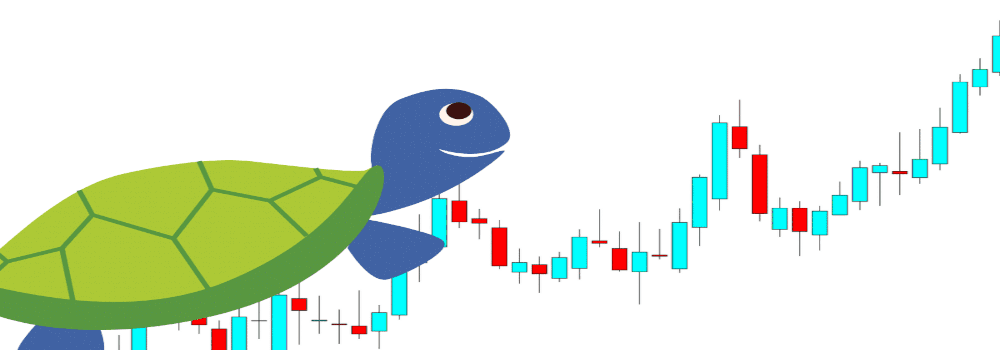
You may have heard the term “Turtle Trader” but what is that? Well today we’re going to find out!
Turtle traders refer to a group of traders who were part of a famous and successful trend-following trading experiment in the 1980s. This experiment was initiated by legendary commodities trader Richard Dennis and his partner William Eckhardt. The goal of the experiment was to determine whether trading skills could be taught or if successful trading was a result of innate talent.
Here’s how the Turtle trading program worked:
- Selection and Training: Dennis and Eckhardt selected a group of individuals from diverse backgrounds and with varying levels of trading experience. These individuals were known as the “Turtle traders.” They were taught a specific set of trading rules and strategies developed by Dennis and Eckhardt. These rules included technical analysis, position sizing, risk management, and trend-following techniques.
- Trading Rules: The Turtle traders were given a precise set of rules to follow when entering and exiting trades. These rules were based on indicators like moving averages and volatility measures. They were designed to identify and profit from trends in various financial markets, including commodities, currencies, and stock futures.
- Risk Management: Risk management was a crucial aspect of the Turtle trading strategy. Each trader was instructed to determine the size of their positions based on the volatility of the market. This meant that when markets were more volatile, traders would reduce their position sizes to limit potential losses.
- Diversification: The Turtle traders were encouraged to diversify their trading across different markets to reduce risk. They were not restricted to trading in any specific asset class.
- Trading Capital: Initially, each Turtle trader was provided with a small amount of trading capital, typically around $1 million, to implement the strategy.
- Profit Sharing: The traders were allowed to keep a portion of the profits they generated, with the remainder going to Dennis and Eckhardt.
The Turtle trading experiment was a remarkable success. Many of the Turtle traders went on to achieve significant returns and become successful traders in their own right. The experiment demonstrated that systematic trading strategies and disciplined risk management could be taught and applied effectively. Below is an example of the above rules put into effect.
- Initial Capital: Let’s assume you start with an initial trading capital of $1,000,000.
- Risk Management: You decide to risk a fixed percentage of your capital on each trade to manage risk. The risk percentage could be 2% of your total capital for this example.
- Position Sizing: You calculate your position size for each trade based on your risk tolerance. With a $1,000,000 capital and a 2% risk, you’re willing to risk $20,000 on a single trade.
- Market Selection: You choose to trade a commodity, such as gold (XAU/USD), using a trend-following strategy.
- Entry and Exit Rules: Your trading system employs moving averages. You buy when the 50-day moving average crosses above the 200-day moving average (a bullish signal), and you sell when the 50-day moving average crosses below the 200-day moving average (a bearish signal).
- Trading Example:
- Let’s say you initiate a trade when the 50-day moving average of gold crosses above the 200-day moving average.
- The current price of gold (XAU/USD) is $1,500 per ounce.
- With your risk management in mind, you calculate your position size. You’re willing to risk $20,000 on this trade.
- You calculate the number of ounces to buy: $20,000 / $1,500 per ounce = 13.33 ounces.
- Since you can’t buy a fraction of an ounce, you round down to 13 ounces. ($19,500 actually invested)
- Stop-Loss: You set a stop-loss order to limit potential losses. Let’s say you set your stop-loss at $1,480 per ounce.
- Take Profit: You also set a take-profit order to lock in profits. You decide to take profit when the price reaches $1,600 per ounce. This would net you $1,300 off your investment.
- Monitoring the Trade: You regularly monitor the trade to see how it progresses. If the price reaches your take-profit level or stop-loss level, you exit the trade accordingly
- Risk Monitoring: Since you’re risking 2% of your capital on this trade, your maximum potential loss is $20,000 (2% of $1,000,000). However, as long as you follow through with your stop-loss then you should only lose about $260 of your $19,500 investment.
The Turtle trading experiment is considered a classic example of how disciplined and systematic trading strategies can lead to success in financial markets. It emphasized the importance of sticking to a well-defined trading plan and managing risk, which are principles that continue to be relevant in the world of trading and investing. The goal isn’t to strike it big in one go, rather it’s to slowly build up capital which allows for greater investments and potential profits in the long run.
Remember that real-world trading involves a lot of uncertainty and market dynamics, and past performance is not indicative of future results. Additionally, actual Turtle traders used more sophisticated rules and strategies, but this example provides a basic idea of how systematic trend-following trading can be executed.

